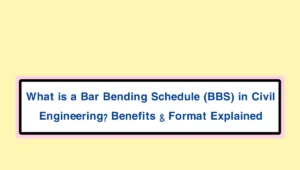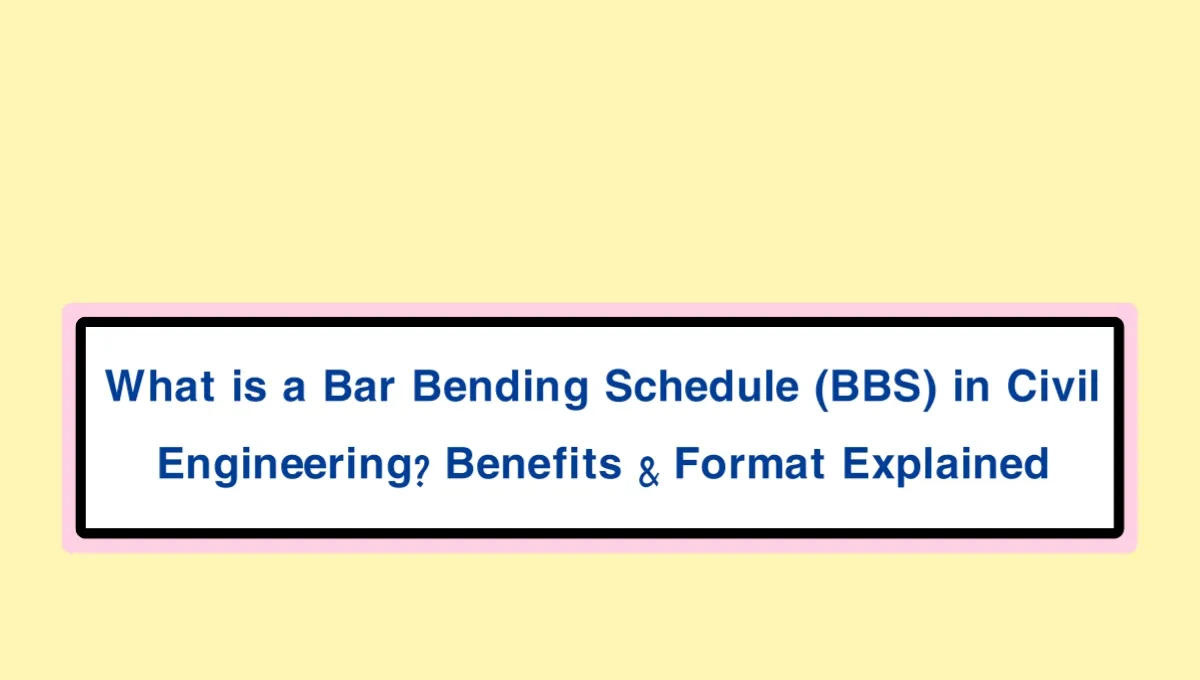What is a Bar Bending Schedule (BBS) in Civil Engineering? Benefits & Format Explained.
In civil engineering, accurate estimation and material planning play a crucial role in the successful completion of construction projects. One of the key tools used for this purpose is the Bar Bending Schedule (BBS). It is a comprehensive list that provides details of the reinforcement bars used in a structure. In this post, we will explain what a BBS is, its components, benefits, and how to prepare one.
What is a Bar Bending Schedule (BBS) in Civil Engineering? Benefits & Format Explained.
What is a Bar Bending Schedule (BBS)?
A Bar Bending Schedule (BBS) is a detailed list of reinforcement bars in a construction project, prepared by engineers to ensure accuracy in cutting, bending, and placing of steel reinforcement. It includes information like bar mark, diameter, type, length, shape, location, and quantity.
BBS helps to determine the exact amount of steel required for a structure, reducing waste and cost.
Why is BBS Important?
- Ensures accurate estimation of steel quantity
- Minimizes material wastage
- Helps in cost control
- Improves work planning and scheduling
- Essential for billing and auditing
- Reduces construction time by avoiding on-site errors
Components of a Bar Bending Schedule
A typical BBS includes the following fields:
| S.No | Bar Mark | Diameter (mm) | Shape | Length (mm) | No. of Bars | Total Length (mm) | Weight (kg) |
|---|---|---|---|---|---|---|---|
| 1 | A1 | 12 | L-type | 1200 | 10 | 12000 | 11.3 |
- Bar Mark: Unique ID for the bar
- Diameter: Thickness of the bar
- Shape: Based on the bar bending (e.g., L, U, crank)
- Length: Calculated length after considering bends
- Quantity: Number of bars
- Weight: Based on standard steel weight formula
Weight of Steel (kg) = (D²/162) x Length (m)
Sample Bar Bending Schedule Format
| Bar Mark | Dia (mm) | Type | Length (m) | No. of Bars | Total Length (m) | Weight (kg) |
| A1 | 12 | Straight | 2.0 | 10 | 20.0 | 17.78 |
| A2 | 10 | L-type | 1.5 | 15 | 22.5 | 13.89 |
How to Prepare a Bar Bending Schedule?
- Obtain Structural Drawings: Get beam, column, slab, and footing drawings.
- Identify Bar Types and Shapes: Determine bar shape, size, and location.
- Measure Dimensions: Calculate required lengths considering bends, hooks, and laps.
- Tabulate in BBS Format: Enter values in a structured table.
- Calculate Weight: Use standard formula to get total steel weight.
Benefits of Using a Bar Bending Schedule
✅ Better material planning
✅ Reduced steel wastage (up to 10-15%)
✅ Improved accuracy in steel ordering
✅ Faster construction timelines
✅ Helps site engineers to cross-check work
✅ Useful during project audits and billing
FAQs on Bar Bending Schedule (BBS)
1. What is the purpose of a bar bending schedule?
A1. A BBS helps estimate, cut, bend, and place reinforcement bars accurately with minimum wastage.
2. Is BBS mandatory in construction projects?
A2. Yes, most large and medium-scale construction projects use BBS for reinforcement planning.
3. How is steel weight calculated in BBS?
A3. Steel weight is calculated using the formula: (D²/162) x Length in meters
4. Can BBS be generated with software?
A4. Yes, tools like AutoCAD, Revit, and Excel sheets with macros are used to prepare BBS.
5. What units are used in BBS?
A5. BBS uses millimeters (mm) for length and kilograms (kg) for weight.
6. What are common bar types in BBS?
A6. Straight bars, L-type, crank bars, stirrups, and U-bars are commonly listed.
7. Who prepares the BBS?
A7. Site engineers or structural detailers usually prepare the bar bending schedule based on design drawings.
Home Page: Click Here

